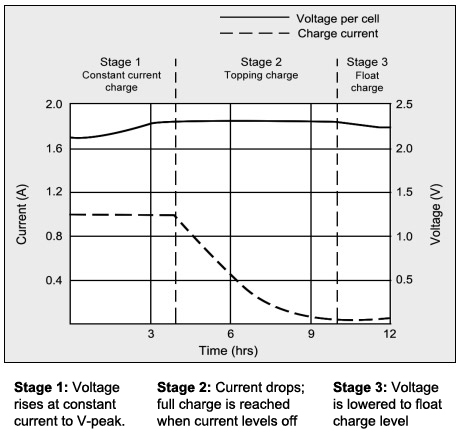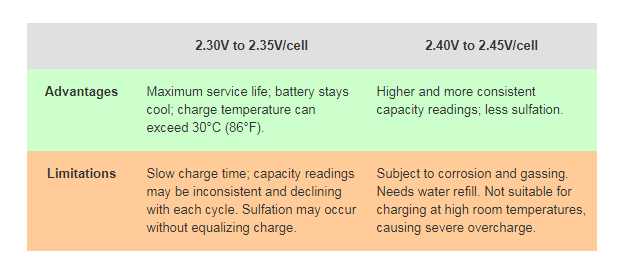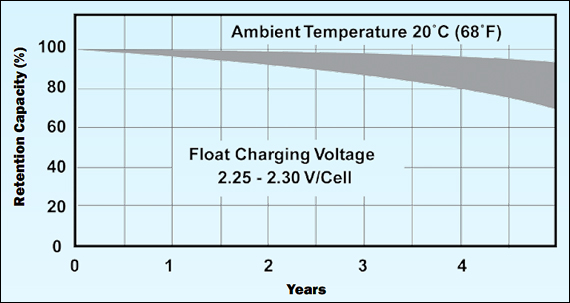Learn how to lead-acid battery voltage optimize charging conditions to extend
Learn how to lead-acid battery voltage optimize charging conditions to extend service life.The lead-acid battery uses the constant current constant voltage (CCCV) charge method. A regulated current raises the terminal voltage until the upper charge voltage limit is reached, at which point the current drops due to saturation. The charge time is 12–16 hours and up to 36–48 hours for large stationary batteries. With higher charge currents and multi-stage charge methods, the charge time can be reduced to 8–10 hours; however, without full topping charge. Lead-acid is sluggish and cannot be charged as quickly as other battery systems. With the CCCV method, lead-acid batteries are charged in three stages, which are [1] constant-current charge, [2] topping charge, and [3] float charge. The constant-current charge applies the bulk of the charge and takes up roughly half of the required charge time; the topping charge continues at a lower charge current and provides saturation, and the float charge compensates for the loss caused by self-discharge. During the constant-current charge, the battery charges to about 70 percent in 5–8 hours; the remaining 30 percent is filled with the slower topping charge that lasts another 7–10 hours. The topping charge is essential for the well-being of the battery and can be compared to a little rest after a good meal. If continually deprived, the battery will eventually lose the ability to accept a full charge and the performance will decrease due to sulfation. The float charge in the third stage maintains the battery at full charge. Figure 1 illustrates these three stages. Figure 1: Charge stages of a lead-acid battery.The battery is fully charged when the current drops to a set low level. The float voltage is reduced. Float charge compensates for self-discharge that all batteries exhibit.
Temperature changes the voltage and this makes “dancing on the head of a pin” more difficult. A warmer ambient requires a slightly lower voltage threshold and a colder temperature prefers a higher setting. Chargers exposed to temperature fluctuations include temperature sensors to adjust the charge voltage for optimum charge efficiency. The charge temperature coefficient of a lead-acid cell is –3mV/°C. Establishing 25°C (77°F) as the midpoint, the charge voltage should be reduced by 3mV per cell for every degree above 25°C and increased by 3mV per cell for every degree below 25°C. If this is not possible, it is better to choose a lower voltage for safety reasons. Table 2 compares the advantages and limitations of various peak voltage settings. Table 2: Effects of charge voltage on a small lead-acid battery.Cylindrical lead-acid cells have higher voltage settings than VRLA and starter batteries.Once fully charged through saturation, the battery should not dwell at the topping voltage for more than 48 hours and must be reduced to the float voltage level. This is especially critical for sealed systems because they are less tolerant to overcharge than the flooded type. Charging beyond the specified limits turns redundant energy into heat and the battery begins to gas. The recommended float voltage of most flooded lead-acid batteries is 2.25V to 2.27V/cell. Large stationary batteries at 25°C (77°F) typically float at 2.25V/cell. Manufacturers recommend lowering the float charge when the ambient temperature rises above 29°C (85°F). Figure 3 illustrates the life of a lead-acid battery that is kept at a float voltage of 2.25V to 2.30V/cell and at a temperature of 20°C to 25°C (60°F to 77°F). After 4 years of operation, permanent capacity losses become visible, crossing the 80 percent line. This loss is larger if the battery requires periodic deep discharges. Elevated heat also reduces battery life. DEEP CYCLE BATTERY VOLTAGE & STATE OF CHARGEIf you’re the owner of a mobile or off-grid solar power system, one of the most obsessive pastimes is determining how much charge you have left in your deep cycle battery bank. This is also known as “state of charge”. Most people view the battery voltage as a measure of this.View our deep cycle battery range While not totally accurate, the easiest way to determine this is with a multimeter if your solar regulator or charge controller doesn’t have a voltage readout. State of charge does vary a little between a sealed lead acid, flooded, gel and AGM deep cycle battery types and also between brands. Even the weather can play a role. Battery voltage state of charge table The table below shows the voltage and approximate state of charge for each type of battery. Note: The figures are based on open circuit readings. That is when the deep cycle battery isn’t under load and hasn’t been under load for a few hours. This scenario may not occur very often in a battery-based system that’s in continual use. So, the best time to take the reading is early in the morning before the sun hits your panels, in the evening as the sun is setting, or when it’s very overcast. If if you take a reading while the battery is receiving a charge, it could read anything up to 14.5 volts. If you take the reading when the panels aren’t exposed to the sun, as there will likely be power being drawn at the time, you can assume that whatever the voltage reading, it’s a conservative estimate. Once all load is removed from a battery, the voltage can bounce back up substantially.
Battery depth of discharge The general rule of thumb: the less your deep cycle battery discharges before recharge, the longer it will last. Here’s an example: A Bullsbattery BPD12V-100 AH Gel Battery discharged to a depth of 70%, i.e. with only 30% or 30 Ah (amp hours) remaining, will have a lifespan of around 1200 cycles, which is quite impressive. However, if it only discharges to 50%, the expected number of cycles skyrockets to around 1700! If a cycle is a day, that adds over 1.25 years to the life of the battery. Depth of discharge, also known as DOD, shouldn’t be any more than 50% in most deep cycle batteries in order to get the best value for money. So if you have a 100 AH battery, consider the cut-off discharge depth being 50 AH. Depth of discharge is a very important calculation you should make when choosing the size of a deep cycle battery. Here’s another example: If you want to power a laptop computer, check the amps rating on the adaptor. It’s likely to be somewhere between the 3 and 5 amp mark. This translates to probably around 2 – 4 amps an hour under normal usage as your laptop won’t be using the full amount at all times. So, based on the lower end: 100 AH battery = 50 AH available capacity/2 amp draw = 25 hours usage. As mentioned, there are 4 main types of conventional deep cycle battery – sealed lead acid, flooded lead-acid, gel, and AGM. To learn more about the difference between them, view our deep cycle battery guide. Use our Remote Area Power Supply (RAPS) system calculator to determine your off-grid solar energy system requirements and suitable components. Need a battery charger? We have had a guide on those as well! |

















